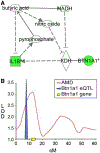Dietary fat alters pulmonary metastasis of mammary cancers through cancer autonomous and non-autonomous changes in gene expression
- PMID: 20151316
- PMCID: PMC6314014
- DOI: 10.1007/s10585-009-9302-7
Dietary fat alters pulmonary metastasis of mammary cancers through cancer autonomous and non-autonomous changes in gene expression
Abstract
Metastasis virulence, a significant contributor to breast cancer prognosis, is influenced by environmental factors like diet. We previously demonstrated in an F2 mouse population generated from a cross between the M16i polygenic obese and MMTV-PyMT mammary cancer models that high fat diet (HFD) decreases mammary cancer latency and increases pulmonary metastases compared to a matched control diet (MCD). Genetic analysis detected eight modifier loci for pulmonary metastasis, and diet significantly interacted with all eight loci. Here, gene expression microarray analysis was performed on mammary cancers from these mice. Despite the substantial dietary impact on metastasis and its interaction with metastasis modifiers, HFD significantly altered the expression of only five genes in mammary tumors; four of which, including serum amyloid A (Saa), are downstream of the tumor suppressor PTEN. Conversely, HFD altered the expression of 211 hepatic genes in a set of tumor free F2 control mice. Independent of diet, pulmonary metastasis virulence correlates with mammary tumor expression of genes involved in endocrine cancers, inflammation, angiogenesis, and invasion. The most significant virulence-associated network harbored genes also found in human adipose or mammary tissue, and contained upregulated Vegfa as a central node. Additionally, expression of Btn1a1, a gene physically located near a putative cis-acting eQTL on chromosome 13 and one of the metastasis modifiers, correlates with metastasis virulence. These data support the existence of diet-dependent and independent cancer modifier networks underlying differential susceptibility to mammary cancer metastasis and suggest that diet influences cancer metastasis virulence through tumor autonomous and non-autonomous mechanisms.
Figures



Similar articles
-
Dietary fat-dependent transcriptional architecture and copy number alterations associated with modifiers of mammary cancer metastasis.Clin Exp Metastasis. 2010 May;27(5):279-93. doi: 10.1007/s10585-010-9326-z. Epub 2010 Mar 31. Clin Exp Metastasis. 2010. PMID: 20354763 Free PMC article.
-
Global expression profiling identifies signatures of tumor virulence in MMTV-PyMT-transgenic mice: correlation to human disease.Cancer Res. 2004 Sep 1;64(17):5973-81. doi: 10.1158/0008-5472.CAN-04-0242. Cancer Res. 2004. PMID: 15342376
-
Genotype X diet interactions in mice predisposed to mammary cancer: II. Tumors and metastasis.Mamm Genome. 2008 Mar;19(3):179-89. doi: 10.1007/s00335-008-9096-y. Epub 2008 Feb 21. Mamm Genome. 2008. PMID: 18288525
-
A mouse mammary gland involution mRNA signature identifies biological pathways potentially associated with breast cancer metastasis.J Mammary Gland Biol Neoplasia. 2009 Jun;14(2):99-116. doi: 10.1007/s10911-009-9120-1. Epub 2009 Apr 30. J Mammary Gland Biol Neoplasia. 2009. PMID: 19408105 Review.
-
From genetic abnormality to metastases: murine models of breast cancer and their use in the development of anticancer therapies.Breast Cancer Res Treat. 2006 Mar;96(2):101-13. doi: 10.1007/s10549-005-9067-x. Breast Cancer Res Treat. 2006. PMID: 16319986 Review.
Cited by
-
The phosphorylated prodrug FTY720 is a histone deacetylase inhibitor that reactivates ERα expression and enhances hormonal therapy for breast cancer.Oncogenesis. 2015 Jun 8;4(6):e156. doi: 10.1038/oncsis.2015.16. Oncogenesis. 2015. PMID: 26053034 Free PMC article.
-
Data-driven assessment of eQTL mapping methods.BMC Genomics. 2010 Sep 17;11:502. doi: 10.1186/1471-2164-11-502. BMC Genomics. 2010. PMID: 20849587 Free PMC article.
-
Dairy milk fat augments paclitaxel therapy to suppress tumour metastasis in mice, and protects against the side-effects of chemotherapy.Clin Exp Metastasis. 2011 Oct;28(7):675-88. doi: 10.1007/s10585-011-9400-1. Epub 2011 Jul 8. Clin Exp Metastasis. 2011. PMID: 21739249
-
Dietary fat-dependent transcriptional architecture and copy number alterations associated with modifiers of mammary cancer metastasis.Clin Exp Metastasis. 2010 May;27(5):279-93. doi: 10.1007/s10585-010-9326-z. Epub 2010 Mar 31. Clin Exp Metastasis. 2010. PMID: 20354763 Free PMC article.
-
Neuron membrane trafficking and protein kinases involved in autism and ADHD.Int J Mol Sci. 2015 Jan 30;16(2):3095-115. doi: 10.3390/ijms16023095. Int J Mol Sci. 2015. PMID: 25647412 Free PMC article. Review.
References
-
- Calle EE, Rodriguez C, Walker-Thurmond K et al. (2003) Overweight, obesity, and mortality from cancer in a prospectively studied cohort of U.S. adults. N Engl J Med 348(17):1625–1638 - PubMed
-
- Berclaz G, Li S, Price KN et al. (2004) Body mass index as a prognostic feature in operable breast cancer: the International Breast Cancer Study Group experience. Ann Oncol 15(6):875–884 - PubMed
-
- Carpenter CL, Ross RK, Paganini-Hill A et al. (2003) Effect of family history, obesity and exercise on breast cancer risk among postmenopausal women. Int J Cancer 106(1):96–102 - PubMed
-
- Rose DP, Komninou D, Stephenson GD (2004) Obesity, adipocytokines, and insulin resistance in breast cancer. Obes Rev 5(3):153–165 - PubMed
-
- Lorincz AM, Sukumar S (2006) Molecular links between obesity and breast cancer. Endocr Relat Cancer 13(2):279–292 - PubMed
Publication types
MeSH terms
Substances
Grants and funding
LinkOut - more resources
Full Text Sources
Other Literature Sources
Medical
Research Materials
Miscellaneous

